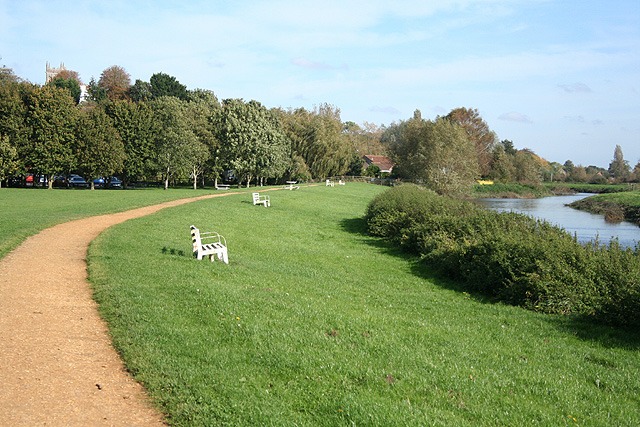
Some of the most breathtaking views in England may be found in the southern section of the county, which features stunning landscapes with rolling hills, picturesque villages, renowned gardens, and ancient mansions
Bruton

Located on the River Brue, Bruton flourished in the Middle Ages because of its abbey. It is today recognised as the most famous town in South Somerset, with a wide variety of boutique stores, farm-to-table dining options, and most famously, Hauser & Wirth. Ten years ago, this top-notch art gallery was founded at Durslade Farm. Using salvaged materials from nearby salvage yards, artist-in-residence Oddur Roth has turned the threshing barn bar into a fully functional, site-specific artwork to celebrate this significant occasion. The 1.5-acre garden, created by Dutch landscaper Piet Oudolf, is free to enter and is magnificent all year round. The farm shop, which sells a variety of meats, cheeses, and freshly made goods, is not to be missed.
Forde Abbey, Chard

Forde Abbey, which borders Dorset and South Somerset, is situated on the floodplain of the River Axe and was founded and landscaped by Cistercian monks some 900 years ago. Having been a home since 1649, the estate’s vast gardens were reshaped during a major landscaping project in the 18th century. The gardens’ present owners have turned them into award-winning landscapes with blooming wildflowers, an arboretum, bog gardens, and gorgeous displays of spring bulbs.
Muchelney

Walking the marshy Somerset Levels requires good footwear, especially if you want to visit the village pond, which is a nature sanctuary in summer with vibrant populations of dragonflies. John Leach, a potter, is the grandson of the well-known artist and potter Bernard Leach. He made this pond. John, who sadly went away, was a major contributor to Leach Pottery’s success, which demonstrated the inventive potential of the abundant local clay. The pottery store regularly conducts exhibitions in addition to selling autographed, valuable pots.
Nearby Muchelney was formerly the site of a wealthy mediaeval abbey. There are still some ruins of this monastery that can be seen, such as the monks’ special thatched lavatory that is supposedly the only one in Britain. The family-run Brown & Forrest smokery is located in the town of Langport and is well-known for its selection of hot and cold smoked foods, including salmon, trout, chicken, duck, pork, pâtés, and cheeses.
The Newt in Somerset, Castle Cary
This 17th-century estate, now a hybrid of opulent hotel and imaginative landscape, was formerly home to garden designer Penelope Hobhouse. 2,000 acres of formal gardens, parkland, cider orchards, and woods were part of the estate that South African businessman Koos Bekker and his wife Karen Roos purchased in 2013. Since then, the site has been developed into a hotel and legacy property. In addition to tours and seasonal activities, visitors can take part in seminars on subjects including beekeeping, dry-stone walling, butchery, and floristry. A membership allows you to visit the garden several times a year. Located next to Castle Cary Station in a beautifully renovated milk factory, the recently rebuilt Creamery and café offers a handy location for rail travellers.
River Parrett Trail

The Somerset Levels are a level area of land with many scenic routes that meander along the willow-fringed banks of the River Parrett, inviting hikers and bikers to explore. Look out for kingfishers, dragonflies, water voles, herons, and otters. One picturesque path starts in Stoke-sub-Hamdon and winds its way to Bower Hinton via farms. After enjoying a leisurely lunch in the quaint market village of Martock, stroll in the direction of Kingsbury Episcopi, which is home to the wonderful Burrow Hill Cider Farm and a 14th-century Hamstone church. Stop at the charming Thorney Mill along the way, then move on to Muchelney and Langport.
Barrington Court, Ilminster
Barrington Court, the site of a former Roman villa, is situated north of Hinton St George. The modern structures are a reflection of the ambitious garden plans of the Lyle family, who acquired and refurbished them a century ago. They are the heirs of the sugar firm. The main garden, the Lily Garden, is still open to tourists, while the Rose and Iris Garden was made by the Lyles with help from the famous Gertrude Jekyll. Make sure to check out the Barrington Boar, a renowned bar and restaurant with four quaint bedrooms with a focus on regional produce. Alternatively, have dinner at the adjacent Trading Post Farm Shop’s quaintly renovated Pip’s Railway Carriage.
South Petherton
The village of South Petherton, which is located beside the Roman Fosse Way, is distinguished for its shining hamstone structures. One noteworthy building is an 1830s bank that is currently the location of one of south Somerset’s most intriguing restaurants, Holm. Chef Nicholas Balfe is a co-founder and leader of Holm, which emphasises on seasonal, local produce. The eatery gathers fruits, vegetables, and herbs from its own garden and smokes trout in-house using applewood from the area. Diners may watch the cooks in action from the eating counter, which can be set aside specifically for this purpose, thanks to the open-plan kitchen. Late in 2021, Holm underwent an expansion that resulted in the addition of seven en suite bedrooms, all furnished with locally made furniture and artwork. Don’t miss the Grade I-listed English Heritage masterpiece, East Lambrook Manor Gardens, created by gardening writer and plantswoman Margery Fish in the 20th century. The garden features meandering walkways among copious borders and a noteworthy plant nursery, especially recognised for its assortment of heritage geraniums.
Lytes Cary, Somerton
The Lyte family owned the quaint manor house for many centuries. It was built in the 1300s. Henry Lyte, an Elizabeth I botanist, looked after the garden. But the garden was damaged and the house fell into decay. After being neglected for 150 years, a new family took over in 1909. After restoring the inside and removing farming equipment and a cider press that had been left inside, they constructed the charming Arts & Crafts garden that is still open to visitors today. Calm strolls throughout the 350 acres of gardens take you alongside the River Cary. There are two places to stay on the estate: a quaint cottage close to the entrance gates, or a section of the great manor house.
Hinton St George

Hinton St George is a very charming community, with its thatched cottages, golden hamstone structures, and flowers hanging from pavement cracks and walls. The Lord Poulett Arms (pronounced “Paulett”), a gastropub that has been there since 1680, is the centre of attention in the community. The restaurant serves a variety of beers and food that are obtained locally. Six bedrooms provide lodging, four of which have en suite bathrooms. The Poulett family chapel, housed in St George’s Church, is well worth a visit because it has several tombs and 13th-century carvings by Wells Cathedral masons.
Ham Hill Country Park

You can get to Ham Hill by taking the A303 west from Lytes Cary. Once an Iron Age hillfort, it is today a wildlife refuge and a favourite location for joggers and walkers due to its amazing vistas. Start your adventure in Stoke-sub-Hamdon and walk up to the summit, where you can stop at the well-liked Prince of Wales tavern for refreshments. Next, make your way to the settlement of Montacute by meandering through the slope forest. Visit Montacute House, a prime example of Elizabethan architecture and design, while you’re at Montacute. The National Trust owns the home, which was built with golden hamstone quarried on the hill, just as much of the surrounding area. There are also two lovely lodges on the estate that can be rented; one is beside the entrance gate, and the other is in the parkland.



